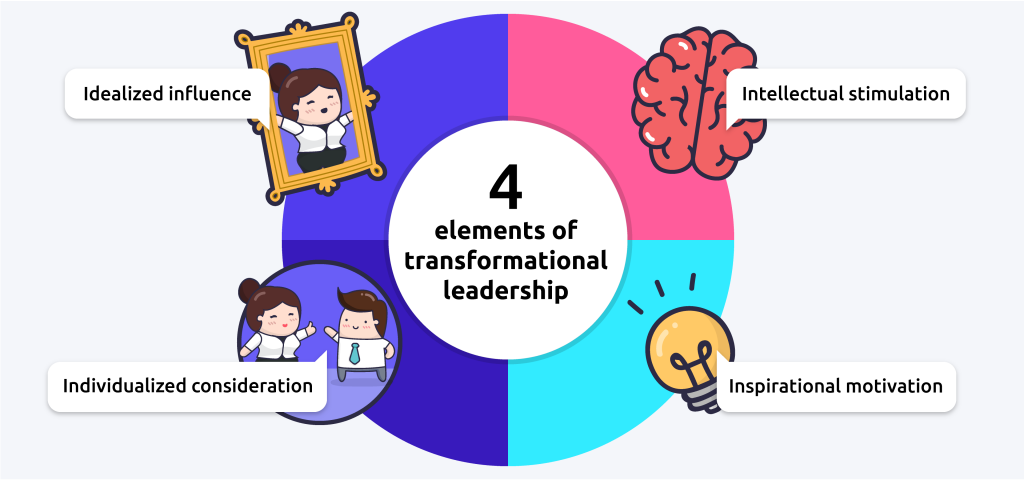Transformational leadership and organizational change: a match made in heaven?
Estimated reading time: 7 minutes
Organizational change has become the rule rather than the exception for many organizations. However, implementing organizational change is a complex process that does not always go to plan or occur easily. Organizational change will often be met with resistance that must be overcome to be successful. When this happens, maintaining the new behavior is not easy. Avoiding potential relapses will require more than, for example, a temporary force such as a change manager who leaves when the set goals have been achieved. Genuinely embedding changes in an organization requires adequate and effective leadership. Is transformational leadership the leadership your organization needs for a successful organizational change?
Table of contents
Transformational vs. transactional leadership
The way leaders interact with their employees and build relationships with their teams substantially impacts employees’ motivation, performance, and engagement. It can affect whether employees are ready to transform or change their behavior. And through changing behavior or transforming employees, indeed organizations can transform, too–and organizational change can be implemented successfully.
Transactional leadership
One of the most extensive leadership theories of organizational transformation is the Transformational and Transactional leadership theory. Transactional leaders provide rewards in exchange for their employees’ performances (and punishments if results are lacking).
Bernard Bass, who refined the transactional leadership theory and introduced it into the organizational context, defines transactional leaders as ‘leaders developing exchanges or agreements with followers, and pointing out what the followers will receive if they do something right as well as wrong’. Employees are rewarded when meeting certain clearly defined goals. This leadership style is associated with static organizational behavior.
Transformational leadership
Transformational leadership goes beyond transactional leadership. Transformational leaders encourage, inspire, and motivate employees to innovate and create change. This change will help grow and shape the company’s future success. They inspire employees to identify with the leader’s vision and to work for the greater good. They sacrifice their self-interest for that of the group or the organization. The foundations for this leadership style are positive interpersonal relationships and employee ownership and independence.
Transformational leaders encourage, inspire and motivate employees ton innovate and create change, which will help grow and shape the organization’s future success.
The ‘transformational’ aspect of this leadership style refers to the aim to equip employees with the confidence and ability to transform and adjust and become more innovative in their approach to work. Research has shown that transformational leadership is based on these four different elements incorporated into this leadership concept:
- Idealized influence (charisma): this is leadership behavior that results in employee admiration, respect, and trust. To employees, the leader is a role model who leads by example by demonstrating ethical behaviors. Idealized influence involves risk-sharing on the part of leaders, considering follower needs over personal needs: leaders practicing idealized influence put their employees’ needs above their own.
- Intellectual stimulation: this involves stimulating employees to question current organizational assumptions, explore different ways of working, develop new and different solutions to common problems, and conduct work in new ways. Leaders stimulate innovation and creativity among their team members. Leaders allow mistakes, empower employees to make decisions, and provide them with the needed support to implement these decisions.
- Individualized consideration: this involves demonstrating genuine concern for the needs and feelings of employees and coaching them through situations and issues. Leaders show empathy, support, and respect for each individual employee and recognize each individual’s contribution to common success.
- Inspirational motivation: the focus here is on clearly stating the organization’s vision and goals and connecting them to the employees’ values and goals. Facilitating a feeling of optimism and a commitment to organizational goals and vision is part of these behaviors.

By incorporating these leadership behaviors into their leadership style, transformational leaders create positive change among their team members. They care about employees’ personal interests and always act in the group’s interests.
Organizational change: positive associations required
Organizational change has been associated with an array of potentially negative results for both individuals and organizations. At an organizational level, change has been related to reduced productivity, increased health care expenses, absenteeism, and the intention to quit. Additionally, at the individual level, change has been associated with job satisfaction, stress, psychological well-being, and time pressure.
Given these negative associations with organizational change and the increase in range and frequency of organizational change, positive reactions to change are vital for organizations: they can be the difference between failure and success. Processes or methods that could potentially contribute to positive associations are crucial.
Transformational leadership and organizational change
Transformational leadership is one of the methods that could contribute to those positive associations. Leadership behavior influences the well-being of employees–an influence that lasts during organizational change when managers play important roles both as role models and drivers of change.
By incorporating ‘charismatic and visionary leadership,’ transformational leaders can look to influence fundamental change within organizations. They do this by paying attention to the concerns and developmental needs of individual employees. They help their employees look at old problems in a new way and, in doing so, change employees’ awareness of issues.
During change, the four different dimensions incorporated into transformational leadership result in leadership behaviors that provide a psychological focal point for employees.
During organizational change, the four different dimensions incorporated into transformational leadership result in leadership behaviors that provide a psychological focal point for employees. Transformational leaders offer a role model who demonstrates desired actions, focuses on aligning employees’ goals and organizational goals, stimulates employees to explore different ways of working, and coaches them through challenges along the way.
Additionally, employees will positively appraise the change if leaders display the following behaviors:
- Involve employees,
- Communicate clearly,
- Share their knowledge regarding the upcoming change,
- Actively work towards the change,
- Provide information regarding the change,
- Talk about the consequences for every individual,
- Stay positive about the change.
Transformational leadership and communication
Many of these behaviors require reliable and accessible communication channels. Face-to-face communication is crucial in helping individual employees through all the challenges an organizational change brings with it. Implementing a change by intellectual stimulation calls for one-on-one or team sessions and coaching.

However, studies agree departmental, or organization-wide communication is imperative in transformational leadership during organizational change. Organization-wide channels that can also target specific locations, departments, teams, or individuals, such as digital signage, corporate screensavers, or an employee app, are essential for:
- Displaying appropriate behaviors,
- Celebrating success and sharing success stories,
- Providing and sharing a clear vision and organizational goal,
- Providing a vision of a possible future that is attractive and engaging,
- Sharing important information regarding the change, which can also be done by creating a dedicated SharePoint page and connecting SharePoint to digital signage screens or screensavers – this way, important information is brought to employees, so they don’t have to search for it,
- Promoting (the new) organizational culture,
- Keeping the change efforts top of mind,
- Providing platforms for discussion, such as a Microsoft Teams channel or a corporate app where employees can share their thoughts, questions, and uncertainties with their peers,
- Sharing KPIs by, for example, connecting digital signage screens to Power BI,
- Share internal influencer stories,
- Drive mobile-first employee communications.
Change management depends on leadership to be enacted, and clear communication is a vital part of successful change management. Do you want to know how your organization can benefit from transformational leadership and clear leadership communication during your organizational change? Get in touch with our consultants; they are happy to help you. Do you want to know what else can complicate your organizational change? Download our infographic ‘4 Forces that Make or Break your Organizational Change‘ to find out what else you can do to make your organizational change a success.

How can technology like Netpresenter help leaders drive transformation effectively?
Netpresenter’s communication platform enables leaders to maintain a visible and consistent presence across all levels of the organization, especially during transformation. With features like digital signage, mobile alerts, screensavers, and targeted content delivery, leaders can:
Reinforce strategic messages,
Share success stories,
Gather feedback,
Maintain momentum during change initiatives.
The article makes clear that when leadership vision is backed by consistent, visible communication, change becomes more manageable and motivating for employees.
How can internal communication support transformational leadership?
Internal communication amplifies the influence of transformational leaders by ensuring their vision, values, and strategy are consistently and clearly conveyed across the organization. Tools like Netpresenter enable leaders to:
Share real-time updates,
Celebrate progress,
Visibly recognize team contributions,
Keep everyone aligned and informed during change.
The article stresses that communication is the foundation for trust, motivation, and cultural alignment.
Why is transformational leadership so effective during periods of organizational change?
The article explains that transformational leaders are uniquely positioned to navigate change because they create a compelling vision, communicate transparently, and engage employees at an emotional level. This helps reduce resistance, increase adaptability, and build commitment. Their ability to connect with people and champion new directions makes them powerful agents of successful transformation.
